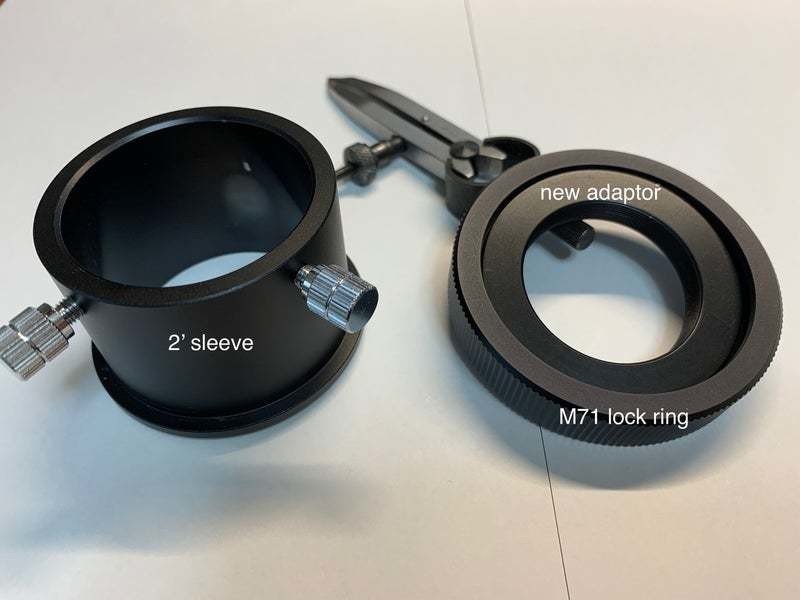
Right angle correct image (RACI), reduced-F binoviewing in μ-210
Abstract
So far, I found that we could accomplish a right angle correct image (RACI) binoviewing at 0.82× magnification on Mewlon-210 by using an 1.25× GPC (glass path corrector) in front of the Baader T2 Amici prism and the Alan Gee mark II in back of it. I’m wondering of, however, the narrow clear aperture (24.5mm) of the GPC and resulting lack of the amount of the ray in the peripheral of the FOV. In addition, I have tried only reducers upto 540mm of focal length, and failed to get focus. Therefore, I tried to use a reducer lens with larger aperture and longer fl. I found that a combination of a shortest Mewlon-T2 adaptor and a reducer made with an achromat D=50mm, fl=600mm objective lens gave us a near limit widest field of view (0.81 ×) in a RACI binoviewing on MY Mewlon-210.
1. Custom made ultra low profile adaptor
I ordered a custom made T2 female adaptor which was attached to the rear cell of M-210 with a locknut of its genuin accessory. It shortend the path length of here upto appox. 0 mm, whereas an old custom one had > 10mm.



The male side of the T2 Amici prism was threaded to the adaptor through the locknut. The adaptor will not allow to be tightened / loosened without the holes (red arrows) for pin wrench. At first, I did not notice it so that I drilled them by myself.

2. Making long f.l. reducer
I bought f.l.=600 mm and 800 mm, D=50 mm achromat lenses for beginner’s telescope, and tried 600 mm at first. I planned to mount the lens to a M57-M57 male-male adaptor (Borg (7457)) and sandwich it with M57 T2 female-male adaptors (Kasai trading). The inner diameter of the (7457) was, however, narrower than the outer diameter of the lens. I filed it by hand, then it nicely fitted to the lens.

Moreover, the hight of the 【7457】was approx. 2.5mm higher than that of the lens, so that four O-rings made with cardboard was put on the objective’s side. Onto the “objective side” is important to clear the back focus. Although 2.5mm is not so small loss of the light path here, it finally reached focus.

Three pieces of thin film were inserted between the cell and lens to centering the lens. A O-ring made by flocked paper was inserted between the lens and T2-M57 adaptor as a cushon.

The reducer was completed. The reflection is rather strong due to the single coating.

Here is the adaptor-prisim-reducer assembly. The reducer was threaded to the eyepiece side of the prism. Total path length was 15 + 48 + 28 = 91mm. The 15 mm is the height of the locking ring, so the additional length from the terminal of Mewlon's M71 thread is only 3 mm + α(for clearance)!

3. Field test
I checked the image with a lightning rod always I used. With 24mm 65° eyepiece, I got focus with much of room (>two rotations of focus knob), but it might be edge of focus for infinity. The FOV was a little bit broader than that with pair of GPC + Alan Gee mark II, and estimated at 0.81× compared to without the reducer. The MaxBright II can get broader AFOV and FOV than linear binoviewers (from Orion, Kasai, or TS-optics) which consumes 0 mm path length!

4. Star test
As expected, I could get focus with little room for rotation of the focus knob with Lavendura 40mm, Baader Classic Plössl 32mm, RKE 28mm, Photon (Paradigm) 25mm, UF24mm (an equivalent to APM UFF24mm), Nagler T6 11mm etc, but, unfortunately, not with Ethos 8mm. The image quality is no problem. The UF24mm and Paradigm 25mm can catch the h-x (except for the edge of each cluster) within a FOV!

I believe I could here accomplish the aim to get a widest FOV with RACI, reduced-mag binoviewing on MY Mewlon-210. As a result, this was the simplest and reasonable way among I have tried.
Finally, the present report does not assure all Mewlon-210 can reach focus in this setup. The residual back focus is very tight. Please try it on your own risk.
